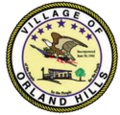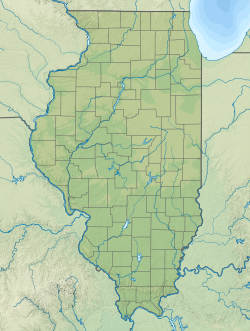Demographics
Historical population| Census | Pop. | Note | %± |
|---|
| 1970 | 470 | | — |
|---|
| 1980 | 2,784 | | 492.3% |
|---|
| 1990 | 5,510 | | 97.9% |
|---|
| 2000 | 6,779 | | 23.0% |
|---|
| 2010 | 7,149 | | 5.5% |
|---|
| 2020 | 6,893 | | −3.6% |
|---|
|
As of the 2020 census [7] there were 6,893 people, 2,386 households, and 1,804 families residing in the village. The population density was 5,978.32 inhabitants per square mile (2,308.24/km2). There were 2,477 housing units at an average density of 2,148.31 per square mile (829.47/km2). The racial makeup of the village was 73.73% White, 8.89% African American, 0.13% Native American, 4.92% Asian, 0.00% Pacific Islander, 3.89% from other races, and 8.44% from two or more races. Hispanic or Latino of any race were 12.39% of the population.
There were 2,386 households, out of which 30.0% had children under the age of 18 living with them, 62.62% were married couples living together, 10.52% had a female householder with no husband present, and 24.39% were non-families. 22.05% of all households were made up of individuals, and 4.95% had someone living alone who was 65 years of age or older. The average household size was 3.49 and the average family size was 2.96.
The village's age distribution consisted of 20.1% under the age of 18, 8.3% from 18 to 24, 28.5% from 25 to 44, 32.3% from 45 to 64, and 10.9% who were 65 years of age or older. The median age was 37.3 years. For every 100 females, there were 110.7 males. For every 100 females age 18 and over, there were 108.6 males.
The median income for a household in the village was $82,337, and the median income for a family was $100,000. Males had a median income of $56,938 versus $36,944 for females. The per capita income for the village was $35,688. About 10.0% of families and 12.4% of the population were below the poverty line, including 35.7% of those under age 18 and 6.0% of those age 65 or over.
According to data compiled between the years of 2010 and 2014, Orland Hills has the third largest percentage of Arab Americans in its population in Illinois, behind only Bridgeview and Chicago Ridge. According to the study, roughly 16.9% of Orland Hill's population is Arab American. It should also be noted that the nearby communities of Orland Park and Tinley Park also have high Arab American populations. [8]
Orland Hills village, Illinois – Racial and ethnic composition
Note: the US Census treats Hispanic/Latino as an ethnic category. This table excludes Latinos from the racial categories and assigns them to a separate category. Hispanics/Latinos may be of any race.| Race / Ethnicity (NH = Non-Hispanic) | Pop 2000 [9] | Pop 2010 [5] | Pop 2020 [6] | % 2000 | % 2010 | % 2020 |
|---|
| White alone (NH) | 5,649 | 5,353 | 4,897 | 83.33% | 74.88% | 71.04% |
| Black or African American alone (NH) | 345 | 538 | 604 | 5.09% | 7.53% | 8.76% |
| Native American or Alaska Native alone (NH) | 10 | 9 | 4 | 0.15% | 0.13% | 0.06% |
| Asian alone (NH) | 224 | 343 | 336 | 3.30% | 4.80% | 4.87% |
| Pacific Islander alone (NH) | 0 | 3 | 0 | 0.00% | 0.04% | 0.00% |
| Other race alone (NH) | 6 | 14 | 15 | 0.09% | 0.20% | 0.22% |
| Mixed race or Multiracial (NH) | 136 | 90 | 183 | 2.01% | 1.26% | 2.65% |
| Hispanic or Latino (any race) | 409 | 799 | 854 | 6.03% | 11.18% | 12.39% |
| Total | 6,779 | 7,149 | 6,893 | 100.00% | 100.00% | 100.00% |
Government
As of 2023, Orland Hills is a part of Illinois' 6th Congressional District which is represented by democrat Sean Casten. Orland Hills has a village board with a mayor. The current mayor of Orland Hills is Kyle R. Hastings Sr. Hastings has been the mayor of Orland Hills since 1993. [10]
As of 2023, Orland Hills is a part of the 37th legislative district in the Illinois House of Representatives, represented by Tim Ozinga, a republican. However, in 2024 Ozinga resigned from his position. He was succeeded by Patrick Sheehan a former police officer in Plainfield, Illinois and an unsuccessful candidate for the Illinois State Senate in 2022, where he lost to incumbent state senator Michael Hastings in the 19th district. The 19th district also encompasses Orland Hills. Sheehan is a republican and resides in Lockport, Illinois.
Education
A majority of students from Orland Hills attend Victor J. Andrew High School (residents who live south of Meadowview Ave), while the rest attend Carl Sandburg High School (residents who live north of Meadowview Ave).
There are two elementary school districts that serve Orland Hills: Kirby School District 140 and the Orland School District 135.
Orland Hills is also home to Cardinal Joseph Bernadine Catholic School, or CJB for short. The school is run by the Roman Catholic Archdiocese of Chicago. Another school located in Orland Hills is a preschool thru 8th grade school is Christian Hills or CHS which is an extension of Christian Hills church.
This page is based on this
Wikipedia article Text is available under the
CC BY-SA 4.0 license; additional terms may apply.
Images, videos and audio are available under their respective licenses.






